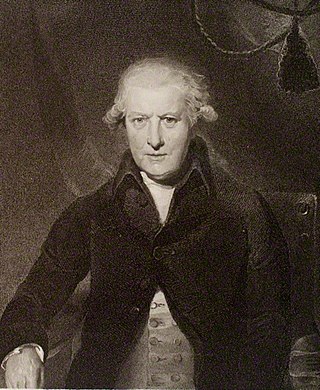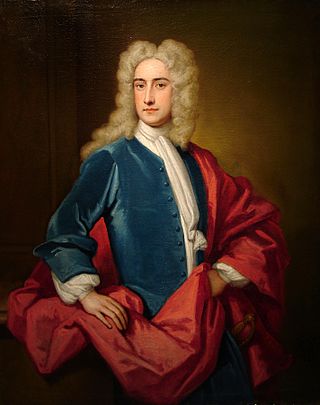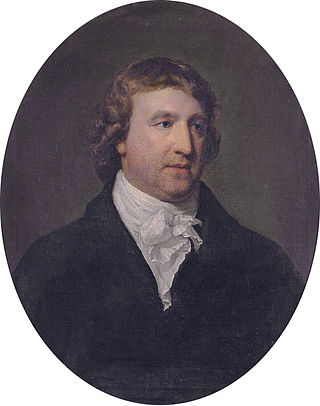
Viscount Barrington, of Ardglass in the County of Down, was a title in the Peerage of Ireland. It was created in 1720 for the lawyer, theologian and politician John Barrington. He was made Baron Barrington, of Newcastle in the County of Limerick, also in the Peerage of Ireland, at the same time.

Viscount Cobham is a title in the Peerage of Great Britain that was created in 1718. Owing to its special remainder, the title has passed through several families. Since 1889, it has been held by members of the Lyttelton family.

Marquess of Sligo is a title in the Peerage of Ireland. It was created in 1800 for John Browne, 3rd Earl of Altamont. The Marquess holds the subsidiary titles of Baron Mount Eagle, of Westport in the County of Mayo, Viscount Westport, of Westport in the County of Mayo, Earl of Altamont, in the County of Mayo, Earl of Clanricarde and Baron Monteagle, of Westport in the County of Mayo. All these titles are in the Peerage of Ireland, except the Barony of Monteagle, which is in the Peerage of the United Kingdom. The latter peerage entitled the Marquesses to a seat in the House of Lords prior to the House of Lords Act 1999. The Earldom of Clanricarde was inherited by the sixth Marquess in 1916 according to a special remainder in the letters patent.

Marquess of Londonderry, of the County of Londonderry, is a title in the Peerage of Ireland.

Earl of Egmont was a title in the Peerage of Ireland, created in 1733 for John Perceval, 1st Viscount Perceval. It became extinct with the death of the twelfth earl in 2011.

Earl of Craven, in the County of York, is a title that has been created twice, once in the Peerage of England and once in the Peerage of the United Kingdom.

Earl of Limerick is a title that has been created twice in the Peerage of Ireland, associated first with the Dongan family, then with the Pery family. It should not be confused with the title Viscount of the City of Limerick held by the Hamilton family also Earls of Clanbrassil.

Earl of Norbury, in the County of Tipperary, is a title in the Peerage of Ireland. It was created in 1827, along with the title Viscount Glandine, of Glandine in the King's County, for the Irish politician and judge John Toler, 1st Baron Norbury, upon his retirement as Chief Justice of the Common Pleas in Ireland. The titles were created with special remainder to his second son, Hector, as his eldest son, Daniel, was then considered mentally unwell. Lord Norbury had already been created Baron Norbury, of Ballycrenode in the County of Tipperary, in the Peerage of Ireland in 1800, with remainder to the heirs male of his body. Moreover, his wife, Grace Toler, had been created Baroness Norwood, of Knockalton in the County of Tipperary, in the Peerage of Ireland in 1797, with remainder to the heirs male of her body. By the time Lord Norbury was raised to the Earldom, his wife had died and their eldest son had succeeded her as 2nd Baron Norwood. This son also succeeded Lord Norbury himself on his death in 1831 as 2nd Baron Norbury, whilst his younger brother Daniel succeeded to the viscountcy and earldom according to the special remainder. In 1832, the second Earl also succeeded his elder brother in the two baronies. He had already in 1825 assumed the additional surname of Graham by Royal licence.

Viscount Massereene is a title in the Peerage of Ireland. It was created in 1660, along with the subsidiary title of Baron Loughneagh. From 1665 to 1816 the Skeffington Baronetcy of Fisherwick was attached to the viscountcy and from 1756 to 1816 the Viscounts also held the title of Earl of Massereene. Since 1843 the peerages are united with titles of Viscount Ferrard, of Oriel and Baron Oriel, both in the Peerage of Ireland, and Baron Oriel, in the Peerage of the United Kingdom. The Viscount also holds the subsidiary titles of Baron Loughneagh (1660) and Baron Oriel (1790) in the Peerage of Ireland and Baron Oriel (1821) in the Peerage of the United Kingdom. As Baron Oriel, he sat in the House of Lords until 1999.

Viscount Charlemont is a title in the Peerage of Ireland. It was created in 1665 for William Caulfeild, 5th Baron Charlemont.

Viscount Gort is the title of two peerages in British and Irish history. Gort is a small town in County Galway in the West of Ireland. The original title was in the Peerage of Ireland and is extant. A viscountcy with the same title as the Irish peerage was then conferred in the Peerage of the United Kingdom to a later Lord Gort. This gave the distinguished descendant a subtle personal change of status, whilst preserving the heritage of the older title. The United Kingdom title, however, became extinct on the death of the original recipient, who remains perhaps the most illustrious bearer of the older title to date. A post-World War II unqualified reference to "Lord Gort" will almost always be to the sixth viscount.

Baron Castlemaine, of Moydrum in the County of Westmeath, is a title in the Peerage of Ireland. It was created in 1812 for William Handcock, with remainder to his younger brother Richard Handcock. Handcock represented Athlone in Parliament and also served as Governor of County Westmeath. In 1822 he was further honoured when he was made Viscount Castlemaine in the Peerage of Ireland, with remainder to the heirs male of his body.

Baron Sandys is a title that has been created three times, once in the Peerage of England, once in the Peerage of Great Britain and once in the Peerage of the United Kingdom.
Baron de Freyne, of Coolavin in the County of Sligo, is a title in the Peerage of the United Kingdom. It was created in 1851 for Arthur French, 1st Baron de Freyne, with remainder to his younger brothers John, Charles and Fitzstephen French. He had earlier represented County Roscommon in the House of Commons and later served as Lord Lieutenant of County Roscommon. French had already been created Baron de Freyne, of Artagh in the County of Roscommon, in 1839, also in the Peerage of the United Kingdom but with normal remainder to heirs male. Lord de Freyne was childless and on his death in 1856 the barony of 1839 creation became extinct. The barony of 1851 creation survives according to the special remainder by his younger brother John, the second Baron.

Earl or Lord of Clanricarde is a title that has been created twice in the Peerage of Ireland, first in 1543 and again in 1800. The former creation became extinct in 1916 while the 1800 creation is extant and held by the Marquess of Sligo since 1916.

Viscount Midleton, of Midleton in the County of Cork, is a title in the Peerage of Ireland. It was created in 1717 for Alan Brodrick, 1st Baron Brodrick, the Lord Chancellor of Ireland and former Speaker of the Irish House of Commons. He was created Baron Brodrick, of Midleton in the County of Cork, in 1715 in the same peerage. His grandson, the third Viscount, co-represented Ashburton then New Shoreham in the British House of Commons. His son, the fourth Viscount, sat similarly for Whitchurch for 22 years. In 1796 he was created Baron Brodrick, of Peper Harrow in the County of Surrey, in the Peerage of Great Britain, with a special remainder to the heirs male of his father, the third Viscount. On the death of his son, the fifth Viscount, this line of the family failed.
John Prendergast-Smyth, 1st Viscount Gort was an Irish politician.

General Ulysses de Burgh, 2nd Baron Downes, was an Irish soldier and Tory politician. A General in the British Army, he served as Surveyor-General of the Ordnance under Lord Liverpool (1820–27) and, after succeeding a cousin as second Baron Downes (1826), he was an Irish Representative Peer in the House of Lords (1833–64).

William Downes, 1st Baron Downes PC was one of the leading Irish judges of his time, who held office as Lord Chief Justice of Ireland.
Thomas Burgh was an Anglo-Irish politician who was elected MP for Lanesborough in the Irish House of Commons (1727–1758).












